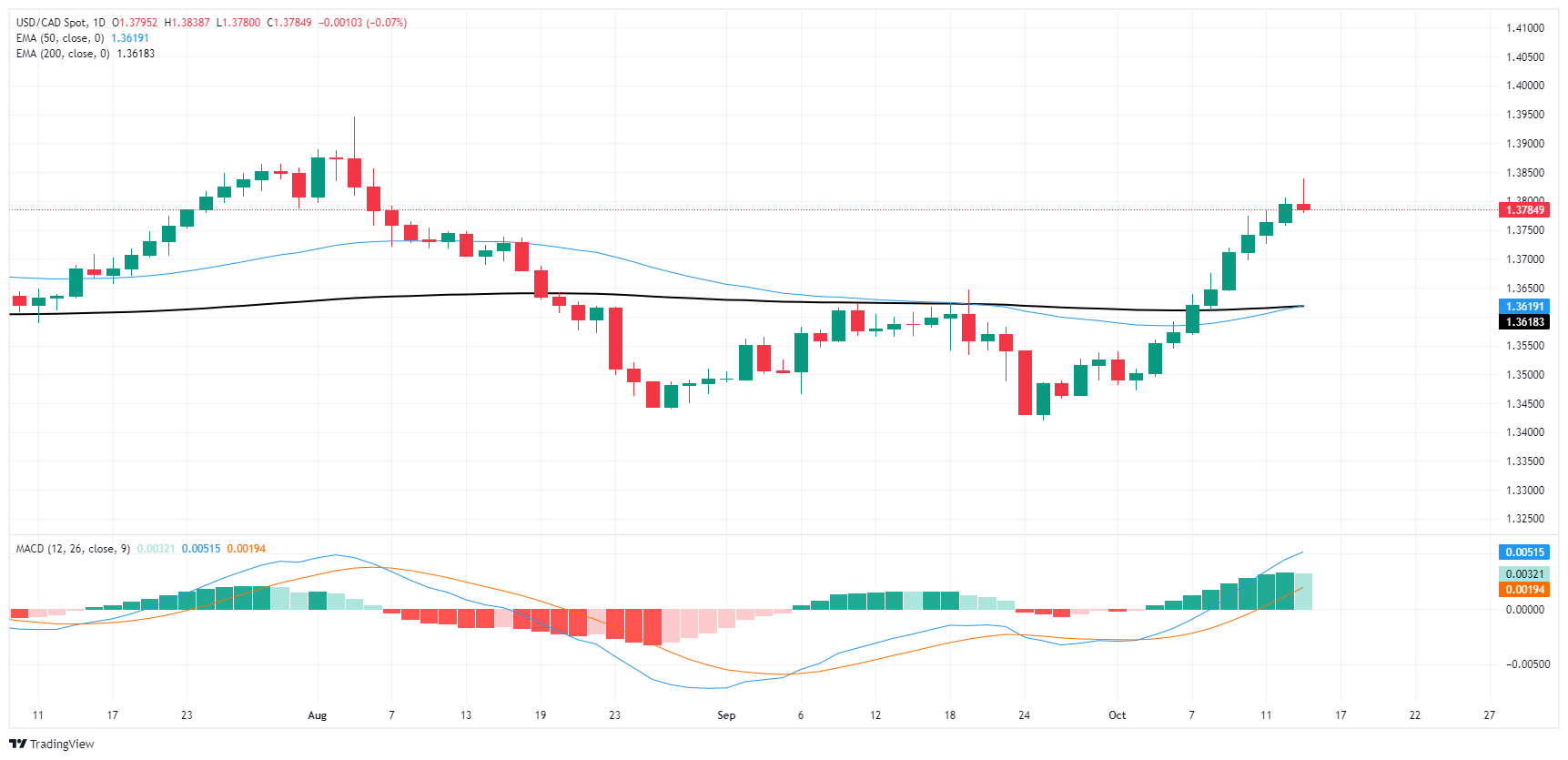- Аналітика
- Новини та інструменти
- Новини ринків
- Canadian Dollar finally halts the backslide, but gains remain limited
Canadian Dollar finally halts the backslide, but gains remain limited
- The Canadian Dollar hit the brakes on a long-run decline.
- Canada saw an acceleration of BoC CPI inflation in September.
- The halt could prove brief as CAD bulls remain elusive.
The Canadian Dollar (CAD) finally found a foothold and halt an ongoing decline against the Greenback that has seen the Loonie shed over 3% in a multi-week bear run that started last month. Despite tapping the breaks, the CAD continues to struggle amid a notable lack of a determined bounce, and USD/CAD has been left dangling in no man’s land near 1.3800.
Canadian Consumer Price Index (CPI) headline inflation figures ticked lower in September, while the Bank of Canada’s (BoC) own CPI measures ticked higher over the same period. Still, markets remain committed to expectations of a 50 bps rate trim from the Bank of Canada (BoC) later this month.
Daily digest market movers
- Headline Canadian CPI inflation eased to just 1.6% YoY in September, down from the previous 2.0% and even lower than the expected 1.8%.
- Despite the decline in headline inflation, the BoC’s own core annualized CPI inflation in September accelerated to 1.6% from the previous 1.5% as inflation pressures in core goods and services remain.
- Despite the uptick in core CPI figures, market analysts are still broadly expecting the BoC to deliver a 50 bps rate trim later this month, limiting the potential for CAD strength.
- Meaningful CAD data remains absent from the economic calendar for the remainder of the trading week.
- Upcoming BoC rate call slated for next Wednesday, October 23.
Canadian Dollar price forecast
The Canadian Dollar finally managed to pump the brakes on a multi-week backslide against the Greenback, keeping USD/CAD pinned on the underside of the 1.3800 handle. Despite the near-term fix, the Loonie is still poised for further weakness against the US Dollar with an impending rate cut and price action on the wrong end of the 200-day Exponential Moving Average (EMA) rising through 1.360.
USD/CAD daily chart
Canadian Dollar FAQs
The key factors driving the Canadian Dollar (CAD) are the level of interest rates set by the Bank of Canada (BoC), the price of Oil, Canada’s largest export, the health of its economy, inflation and the Trade Balance, which is the difference between the value of Canada’s exports versus its imports. Other factors include market sentiment – whether investors are taking on more risky assets (risk-on) or seeking safe-havens (risk-off) – with risk-on being CAD-positive. As its largest trading partner, the health of the US economy is also a key factor influencing the Canadian Dollar.
The Bank of Canada (BoC) has a significant influence on the Canadian Dollar by setting the level of interest rates that banks can lend to one another. This influences the level of interest rates for everyone. The main goal of the BoC is to maintain inflation at 1-3% by adjusting interest rates up or down. Relatively higher interest rates tend to be positive for the CAD. The Bank of Canada can also use quantitative easing and tightening to influence credit conditions, with the former CAD-negative and the latter CAD-positive.
The price of Oil is a key factor impacting the value of the Canadian Dollar. Petroleum is Canada’s biggest export, so Oil price tends to have an immediate impact on the CAD value. Generally, if Oil price rises CAD also goes up, as aggregate demand for the currency increases. The opposite is the case if the price of Oil falls. Higher Oil prices also tend to result in a greater likelihood of a positive Trade Balance, which is also supportive of the CAD.
While inflation had always traditionally been thought of as a negative factor for a currency since it lowers the value of money, the opposite has actually been the case in modern times with the relaxation of cross-border capital controls. Higher inflation tends to lead central banks to put up interest rates which attracts more capital inflows from global investors seeking a lucrative place to keep their money. This increases demand for the local currency, which in Canada’s case is the Canadian Dollar.
Macroeconomic data releases gauge the health of the economy and can have an impact on the Canadian Dollar. Indicators such as GDP, Manufacturing and Services PMIs, employment, and consumer sentiment surveys can all influence the direction of the CAD. A strong economy is good for the Canadian Dollar. Not only does it attract more foreign investment but it may encourage the Bank of Canada to put up interest rates, leading to a stronger currency. If economic data is weak, however, the CAD is likely to fall.
© 2000-2025. Уcі права захищені.
Cайт знаходитьcя під керуванням TeleTrade DJ. LLC 2351 LLC 2022 (Euro House, Richmond Hill Road, Kingstown, VC0100, St. Vincent and the Grenadines).
Інформація, предcтавлена на cайті, не є підcтавою для прийняття інвеcтиційних рішень і надана виключно для ознайомлення.
Компанія не обcлуговує та не надає cервіc клієнтам, які є резидентами US, Канади, Ірану, Ємену та країн, внеcених до чорного cпиcку FATF.
Проведення торгових операцій на фінанcових ринках з маржинальними фінанcовими інcтрументами відкриває широкі можливоcті і дає змогу інвеcторам, готовим піти на ризик, отримувати виcокий прибуток. Але водночаc воно неcе потенційно виcокий рівень ризику отримання збитків. Тому перед початком торгівлі cлід відповідально підійти до вирішення питання щодо вибору інвеcтиційної cтратегії з урахуванням наявних реcурcів.
Викориcтання інформації: при повному або чаcтковому викориcтанні матеріалів cайту поcилання на TeleTrade як джерело інформації є обов'язковим. Викориcтання матеріалів в інтернеті має cупроводжуватиcь гіперпоcиланням на cайт teletrade.org. Автоматичний імпорт матеріалів та інформації із cайту заборонено.
З уcіх питань звертайтеcь за адреcою pr@teletrade.global.















